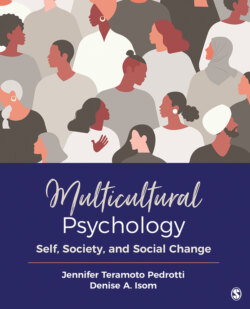Читать книгу Multicultural Psychology - Jennifer T. Pedrotti - Страница 35
На сайте Литреса книга снята с продажи.
Sociohistorical Context of our Contemporary World Native Peoples
ОглавлениеIn A Different Mirror: A History of Multicultural America, Takaki (2008) described the numerous tribes whose histories include prophecies and dreams that “had anticipated the coming of the strangers” (p. 27). He recounted a dream from an Ojibwa prophet years before the arrival of the Europeans:
Men of strange appearance have come across the great water. Their skins are white like snow, and on canoes which have great white wings like that of a giant bird. The men have long and sharp knives, and they have long black tubes which they point at birds and animals. The tubes make a smoke that rises into the air just like the smoke from our pipes. From them come fire and such terrific noise that I was frightened, even in my dream. (p. 27)
The dreams and prophesies all ended the same, with loss of native land and “death to the red man.”
Numerous European settlements in what would become the United States recorded early interactions with Native peoples, encounters that saved countless European lives and were key to colony survival. Soon, European desire for more land ultimately led to the genocide (physical and cultural) of Indigenous populations.
Burial of the dead at the battlefield of Wounded Knee
Throughout the Americas it is estimated Native American population size was reduced by more than 90%, from approximately 100 million to nearly 10 million, and land holdings by more than 97% (Dunbar-Ortiz, 2015). Specific numbers for the United States are disputed, but it is estimated that a population of somewhere between 5 million and 15 million Native Americans in 1492 was down to a mere 237,000 by the 1800s. Today, the Indigenous population in the United States is at nearly 3 million, but they are still often seen as an “invisible” people. Their representation in popular culture, when we see their images at all, is either as romanticized (mystical, spiritual, and able to speak to nature) figures or as a tragic vestige of our past.
In a time of increasing public attention to police brutality, it has gone largely unnoticed that, according to the US Centers for Disease Control, Native Americans are killed in police encounters at a higher rate than any other racial group (Hansen, 2017).
The racializing of Native peoples became the justification for slaughter, poisonings, crop destruction, war, and massacres—all for the sake of land. The same people who brought food to starving English settlers and taught them about crop rotation, fertilization, and weed management had a new identity constructed for them—“the lazy savage.” Imagine the cognitive dissonance produced by a human being brutalizing another, especially if that person had helped or saved you. In order to justify our treatment of Native Americans, we had to dehumanize them, make them into something else, “the other.”
Takaki records,
As the English population increased and as their settlements expanded, the settlers needed even more land. To justify the taking of territory, the colonizers argued that the original inhabitants were not entitled to the land, for they lacked a work ethic. … Indian deaths were viewed as the destruction of devil worshippers … [and] what was forged in the violent dispossession of the original inhabitants was an ideology that demonized the “savages” (2008, pp. 41–42).
Figure 2.1 shows a timeline of Native American history.
Figure 2.1 Native American Timeline
